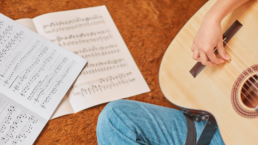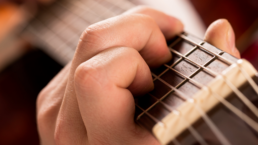Music has this incredible ability to captivate our hearts and stir our emotions. It's the language that transcends boundaries, and for aspiring guitarists, the quest to play beloved tunes can often seem like an elusive dream. But fear not, for there's a secret weapon in the musician's arsenal: the 4-chord song.
RELATED: Learn all of the chords to play your favorite songs at TrueFire >
The beauty of 4-chord songs lies in their simplicity. With just a handful of chords, even a beginner can strum along and produce melodies that resonate with the soul. These songs, adorned by the magic of only four chords, have graced countless stages and playlists, becoming the backbone of pop music and a starting point for many budding guitar enthusiasts.
So, what makes these songs so accessible and appealing? It’s all about the chord progressions, typically revolving around the I-IV-V chord structure. These fundamental chords create the foundation for a vast array of tunes across different genres. The most common combination includes the chords G, D, E minor, and C, but the variations are practically endless.
Let’s break it down:
G: A chord that radiates a sense of familiarity and comfort. Its open and resonant nature makes it a perfect starting point for many songs.
D: With its uplifting and dynamic tone, the D chord injects energy into the music, often serving as a transition to other chords.
E Minor: This melancholic yet beautifully emotive chord brings depth to the progression. It’s the heartstring-tugger in the quartet.
C: Closing the loop is the C chord, offering a sense of resolution and completeness to the progression.
The real allure of these 4-chord wonders isn’t just their simplicity, but the sheer number of songs they can unlock. From classics to contemporary hits, the world of music opens up when armed with these four simple but versatile chords. Iconic tracks from artists like The Beatles, Bob Marley, Ed Sheeran, and countless others can be deciphered and played with these foundational chords.
One might wonder, "Is it really that easy?" In many ways, yes. While mastery takes time and practice, the beauty of 4-chord songs lies in their accessibility. The chords themselves are relatively uncomplicated for beginners to learn and play, making the experience of strumming along to your favorite tunes a reality sooner rather than later.
Moreover, these songs provide an excellent platform for experimentation. As you grow more confident, you can explore variations, rhythm changes, and even embellishments, adding your unique touch to the music.
The journey of a guitarist starts with these simple progressions, offering a gateway to a world of music waiting to be explored. With dedication and practice, these foundational chords lay the groundwork for more intricate compositions and an ever-growing repertoire.
So, whether you’re just starting your musical voyage or seeking an easy way to enjoy playing your favorite tunes, 4-chord songs are your golden ticket. Embrace the simplicity, strum away, and let the magic of these foundational chords pave the way for your musical odyssey.
In the world of guitar, these four chords aren’t just notes; they are the beginning of a beautiful melody, a melody that's waiting for you to play.
RELATED: Learn all of the chords to play your favorite songs at TrueFire >
November 13, 2023
If you're a budding guitarist or a seasoned player looking to expand your skills, mastering guitar chords is a fundamental step toward becoming a proficient musician. Whether you're into rock, pop, jazz, or any other genre, understanding and playing guitar chords is crucial. In this listicle, we'll take you through 7 easy steps to help you become a chord-savvy guitarist. Let's dive right in!
RELATED: Learn 80 Guitar Chords on TrueFire >
1. Learn the Basics
Before diving into more advanced chords, make sure you have a solid understanding of the basics. Start with open chords like C, G, D, E, and A. These are the foundation of many songs and will give you a strong base to build upon.
2. Power Up with Barre Chords
Barre chords are a significant step in your guitar journey. They allow you to play any chord up and down the neck. Start with F major and B minor barre chords, and practice transitioning between them. This skill will significantly broaden your chord repertoire.
3. Explore Seventh Chords
Seventh chords (e.g., A7, E7, B7) add flavor to your playing and are commonly used in blues and rock music. Learn to play these chords and experiment with their variations.
4. Master the Sus and Add Chords
Sus (suspended) and add chords can add a unique touch to your playing. Experiment with chords like Asus4 or Dadd9 to create different textures in your music.
5. Practice Fingerpicking Patterns
Fingerpicking can take your chord progressions to the next level. Practice various fingerpicking patterns like Travis picking or classical fingerstyle to add complexity and depth to your chord-playing skills.
6. Explore Jazz Chords
If you're interested in jazz, delve into jazz chords like maj7, min7, and dim7. Jazz chords can be complex but offer a rich, sophisticated sound when used correctly.
7. Learn Chord Progressions
Understanding chord progressions is crucial for songwriting and improvisation. Study common progressions like I-IV-V or II-V-I to gain a deeper appreciation of how chords work together.
Incorporating these 7 steps into your practice routine will help you become a chord expert. But remember, consistency and patience are key. Keep practicing, and you'll notice your guitar playing skills improving over time.
In conclusion, mastering guitar chords is an essential skill for any guitarist. By starting with the basics, exploring various chord types, and practicing regularly, you'll be well on your way to becoming a proficient player. So pick up your guitar, start strumming, and let the world of guitar chords unfold before you. Happy strumming!
RELATED: Learn 80 Guitar Chords on TrueFire >
November 10, 2023
In the vast symphony of musical evolution, few instruments have left an indelible mark as profound as the acoustic guitar. From intimate campfires to grand concert halls, the resonance of its strings has echoed through the corridors of time, shaping genres, influencing artists, and defining the very essence of the music industry. In this exploration, we delve into the rich history and multifaceted impact of the acoustic guitar on the world of music.
RELATED: Learn Acoustic Guitar from Legendary Educators at TrueFire >
The Birth of Harmony: Early Roots
The roots of the acoustic guitar can be traced back centuries, finding its origins in various stringed instruments across different cultures. However, it wasn't until the 19th century that the modern acoustic guitar, as we know it, began to take shape. The craftsmanship of luthiers, the refinement of materials, and the evolution of playing techniques converged to birth an instrument that would transcend cultural boundaries.
Folk Revival and Protest Movements: The Guitar as a Voice
The mid-20th century witnessed a seismic shift in the musical landscape, marked by the folk revival and protest movements. The acoustic guitar became the chosen instrument of troubadours and activists, carrying with it the power to convey raw, unfiltered emotion. Icons like Bob Dylan, Joan Baez, and Woody Guthrie harnessed the simplicity of the acoustic guitar to amplify their messages of change and rebellion, creating an indomitable link between music and social movements.
Unplugged and Intimate: The MTV Phenomenon
The 1980s brought about a resurgence of acoustic music with the advent of MTV's "Unplugged" series. This platform, which showcased artists performing their hits in an acoustic format, catapulted acoustic renditions into popular consciousness. Unplugged sessions became a proving ground for an artist's true musical prowess, stripping away the electronic embellishments and leaving only the soulful resonance of wood and strings. Nirvana's iconic performance on "Unplugged" stands as a testament to the acoustic guitar's ability to transcend genres and captivate diverse audiences.
Acoustic Crossroads: Genre-Bending Brilliance
The versatility of the acoustic guitar has allowed it to seamlessly weave through a myriad of genres, breaking down musical barriers. From the intricate fingerpicking of folk and blues to the percussive rhythms of flamenco and the melodic complexities of classical music, the acoustic guitar has proven itself a chameleon in the hands of skilled musicians. This adaptability has played a pivotal role in the fusion of genres, giving rise to innovative sounds and pushing the boundaries of musical experimentation.
Modern Icons: The Continuing Legacy
In the 21st century, the acoustic guitar remains a focal point in the creation of timeless music. Artists like Ed Sheeran, John Mayer, and Taylor Swift have embraced the acoustic medium, showcasing its enduring appeal and its ability to connect with a global audience. Whether in the intimate confines of a coffeehouse or on the grand stage of a stadium, the acoustic guitar continues to be a symbol of authenticity and a conduit for genuine musical expression.
Conclusion: A Timeless Resonance
As we reflect on the journey of the acoustic guitar through the annals of musical history, it becomes clear that its influence extends far beyond the strumming of strings. It has been a companion to revolutions, a catalyst for change, and a vessel for the human experience. In the hands of artists, it has shaped the narratives of generations and forged connections that defy the boundaries of language.
In the ever-evolving symphony of the music industry, the guitar stands as a timeless instrument, weaving its melodic threads through the fabric of our shared cultural experience. Its resonance is not merely heard; it is felt in the heartbeats of those who listen, forever echoing the soulful journey of the human spirit.
RELATED: Learn Acoustic Guitar from Legendary Educators at TrueFire >
November 9, 2023
Are you looking to join the vibrant community of musicians at your local jam sessions? These gatherings are a goldmine for guitarists eager to flex their improvisational skills, collaborate on-the-fly, and learn from fellow musicians. Whether it’s blues, jazz, rock, or folk that gets your fingers flying, here’s your ultimate guide to making your mark at these musical meetups.
RELATED: Get In The Jam with the Koch Marshall Trio >
1. Equip for Versatility
Your guitar choice should cater to a range of styles. A versatile guitar with both warm and bright tones is ideal. Consider bringing an electric guitar with a simple setup for easy plug-and-play action. Also, a small multi-effects pedal can be handy for quick tone adjustments.
2. Master the Classics
Familiarize yourself with classic tunes and common chord progressions. These are often the backbone of many jam session songs. Blending into a blues shuffle or rock out to a 12-bar blues progression ensures you're ready for anything that comes your way.
3. Sharpen Your Improv Skills
Guitar improvisation is a cornerstone of jam sessions. Work on your scales, arpeggios, and phrasing. Practice playing over backing tracks in various keys and styles to enhance your improvisational techniques and your ear for on-the-spot creativity.
4. Understand Jam Etiquette
Jam session etiquette is as important as your playing. Wait for your turn to solo, and don't overplay when someone else takes the lead. Be mindful of the group dynamic and the direction the music is taking. Your collaborative spirit will be as appreciated as your solos.
5. Listen Actively
Active listening is crucial in a jam setting. Respond to cues from other musicians, and let the music breathe. Sometimes, the notes you don't play are as important as the ones you do. Your ability to complement others will set you apart.
6. Dial in Your Tone
Quickly adjust your tone to fit the jam. You may need a clean sound for a jazz number or a crunchier tone for rock. Your adeptness at guitar tone adjustment can significantly enhance the group's overall sound.
7. Communicate Clearly
Clear communication is key when it’s your turn to lead or when following another musician. Use hand signals, head nods, or verbal cues to indicate changes in dynamics or when you're handing off the solo. Good musical communication keeps the session running smoothly.
8. Embrace Diverse Styles
A jam session can be a whirlwind tour through genres. Being open to and prepared for various musical styles—be it funk, country, reggae, or anything in between—displays your genre flexibility and can make you a sought-after player in the jam community.
9. Learn to Follow
While solos are exciting, knowing how to follow and support the main player is just as important. Develop a strong sense of rhythm and work on complementary parts that can enhance the lead player's solo. This skill will make you a valuable participant in any jam session.
10. Network and Collaborate
Use the jam session for networking. Engage with fellow players, exchange contacts, and discuss music. Be open to collaborations outside of the jam night. These musician networking tips can lead to new projects, gigs, or simply strong friendships within the music scene.
Local jam sessions are a melting pot of talent and creativity, offering a unique platform for guitarists to shine. Bringing the right gear, knowing classic jams, honing your improvisation, and understanding session etiquette set the stage for a great experience. Active listening, tonal versatility, effective communication, genre flexibility, collaborative playing, and networking are the keys to not just participating, but truly standing out in a jam session environment.
So, tune up your strings, warm up your chops, and step into the circle. It’s time to let your guitar do the talking and become a valued member of your local jam night scene.
RELATED: Get In The Jam with the Koch Marshall Trio >
November 8, 2023
For any aspiring guitarist, technical proficiency and creative expression are essential aspects of becoming a master of the instrument. While learning chords, scales, and techniques is crucial, one often overlooked skill that can truly set you apart is ear training. Ear training, or the ability to recognize and replicate musical notes and intervals by ear, is a skill that every guitarist should cultivate. In this blog, we will explore the importance of ear training for guitarists and how it can significantly enhance your playing and musical journey.
RELATED: Learn How to Recognize Tonalities, Intervals, Chords & Rhythms on TrueFire >
Improves Musical Awareness
Ear training enhances your musical awareness by helping you understand the intricacies of music at a deeper level. When you train your ears, you become more attuned to the nuances of pitch, timbre, and rhythm. This heightened awareness allows you to better interpret and express music, making it an indispensable tool for improvisation and composition.
Enhances Melodic Playing
As a guitarist, you want to be able to create beautiful melodies that resonate with your audience. Ear training plays a pivotal role in this by enabling you to hear and replicate melodies accurately. By honing your ability to recognize and reproduce melodies, you can develop a distinct musical voice and captivate your listeners with soulful, memorable tunes.
Improves Chord Progression Mastery
Understanding chord progressions is a fundamental skill for any guitarist. Ear training empowers you to identify and anticipate chord changes in songs, allowing you to play more fluently and adapt to different musical contexts. This ability is invaluable for accompanying other musicians and participating in jam sessions.
Fosters Effective Communication
Musical collaborations often require effective communication between musicians. By having strong ear training skills, you can communicate more efficiently with other band members. You can easily pick up on musical cues, harmonize with fellow musicians, and create a cohesive sound that resonates with your audience.
Enhances Transcription Abilities
Transcribing music by ear is a valuable skill that allows you to learn and play your favorite songs without relying on sheet music or tablature. Ear training improves your transcription abilities by making it easier to decipher melodies, chords, and solos directly from recordings. This skill not only broadens your repertoire but also deepens your understanding of different playing styles.
Boosts Improvisation Skills
Improvisation is an essential part of playing the guitar, especially in genres like jazz, blues, and rock. Ear training equips you with the tools needed to improvise confidently and creatively. By being able to hear and respond to the music in real time, you can develop your unique voice and make your solos more engaging and expressive.
Fosters Musical Versatility
Whether you're into classical, jazz, rock, or blues, ear training is a universally applicable skill. It allows you to adapt to a wide range of musical styles, making you a more versatile and in-demand guitarist.
Conclusion
In the world of guitar playing, technical prowess is undoubtedly essential, but ear training is the secret ingredient that can elevate your skills to new heights. By developing a keen ear for music, you enhance your musical awareness, melodic playing, chord progression mastery, and improvisation abilities. You also become a more effective communicator and gain the invaluable skill of transcribing music by ear. Ear training is the bridge between knowing how to play the guitar and truly understanding the language of music. So, for any aspiring guitarist, ear training is not just important; it's the key to unlocking your full potential and creating music that resonates with both you and your audience. Start your journey today, and you'll be well on your way to becoming a more accomplished and expressive guitarist.
RELATED: Learn How to Recognize Tonalities, Intervals, Chords & Rhythms on TrueFire >
November 6, 2023





